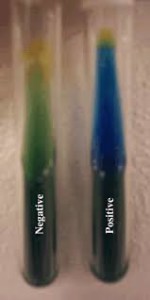Acetamide Utilization test: This test is useful in differentiation of nonfermentative gram-negative bacteria, particularly Pseudomonas aeruginosa.
Principle of Acetamide Utilization Test
Acetamide utilization test is used to check the ability of an organism to use acetamide as a sole source of carbon. Organisms that can grow on this medium are able to deaminate acetamide and release ammonia, causing the change in pH of medium (alkaline). The change in pH is indicated by the change in colour of the indicator (Bromothymol blue) in the medium form green to blue.
Procedure:
- Using a sterile inoculating loop or straight wire, pick a well isolated colony from18-24 hour old culture.
- Inoculate acetamide agar slant by streaking the surface of the slant.
- Incubate the tubes aerobically at 33-37oC for up to with 7 days with loosened caps to ensure adequate aeration.
- Examine the tubes daily for 4 days and again at 7 days before discarding it as negative.
Positive: Deamination of acetamide resulting in change of color of the medium from green to blue
Negative: No change in color or yellow color development
Quality controls:
Positive control: Pseudomonas aeruginosa ATCC 27853
Negative control: Stenotrophomonas maltophilia ATCC 13637
Limitations:
- Acetamide utilization test is not reliable test for identification of pyocyanin producing Pseudomonas aeruginosa.
- Only 38% of non pyocyanin producing strains of Pseudomonas aeruginosa will give positive result.
Composition of Acetamide agar
Acetamide 10. 0 g
Magnesium Sulfate 0.2 g
Sodium Chloride 5.0 g
Monoammonium Phosphate 1.0 g
Dipotassium Phosphate 1.0 g
Bromthymol Blue 0.08 g
Agar 15 g
Demineralized water 1000 ml
Views – 6020

Leave a Comment